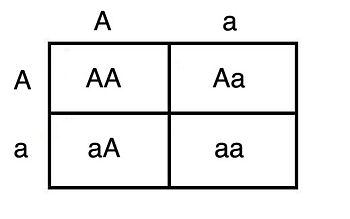Allele: Difference between revisions
imported>Elizabeth Sarah McClure No edit summary |
imported>Elizabeth Sarah McClure No edit summary |
||
| Line 2: | Line 2: | ||
{{EZarticle}} | {{EZarticle}} | ||
An '''allele''' is one version of one member of a set of genes that accounts for variations in genetically inherited characteristics. Alleles were first | An '''allele''' is one version of one member of a set of genes that accounts for variations in genetically inherited characteristics. Alleles were first documented by Gregor Mendel in the flowers of pea plants. He developed a model to explain the 3:1 ratio in the inheritence patterns when breeding purple and white flowering plants. | ||
[[Image:punnett square.JPG|right|thumb|350px|{{#ifexist:Template:punnett square.JPG/credit|{{punnett square.JPG/credit}}<br/>|}}A punnett square shows all possible combinations of alleles in offspring that result from an AA parent and an aa parent.]] | [[Image:punnett square.JPG|right|thumb|350px|{{#ifexist:Template:punnett square.JPG/credit|{{punnett square.JPG/credit}}<br/>|}}A punnett square shows all possible combinations of alleles in offspring that result from an AA parent and an aa parent.]] | ||
Revision as of 22:03, 29 April 2008
An allele is one version of one member of a set of genes that accounts for variations in genetically inherited characteristics. Alleles were first documented by Gregor Mendel in the flowers of pea plants. He developed a model to explain the 3:1 ratio in the inheritence patterns when breeding purple and white flowering plants.
Introduction
For each characteristic, an organism inherits one allele from each parent. Because diploid organisms, organisms with somatic cells that have one set of homologous chromosomes from each parent, have two sets of chromosomes, a genetic locus is represented twice. The locus is represented by alleles. If the alleles at one particular locus are identical, the organism is referred to as homozygous and if they differ it is referred to as heterozygous. If the two alleles at a particular locus differ, then the dominant allele determines the observed trait, or the phenotype. The recessive allele has no observable effect on the organism but is part of the genotype, or genetic make up (set of alleles) present in an organism. However, there are instances in which the recessive allele does affect the phenotype of an organism. One instance is incomplete dominance, a phenomenon in which the heterozygous offspring display a phenotype in between the phenotypes of the parental varieties. This can be seen in the breeding of snapdragons. Snapdragons with red petals crossed with those with white can produce snapdragons with pink petals. Another instance is the codominance of both alleles. This is when the alleles simultaneously affect the phenotype in seperate ways. This is apparent in the human MN blood group where both M and N molecules appear on the red blood cells of individuals with the MN genotype.
